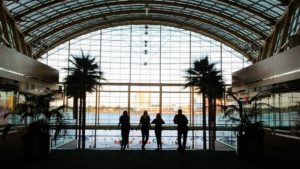
This past Easter weekend, I made plans to go portaging with my family in our favourite camping grounds in central Ontario, Algonquin Park. Portaging truly removes you from the modern world – leaving behind phones, laptops, TVs, allowing oneself to become immersed with nature.
Looking forward to this experience it reminded me that we are not always so fortunate to experience the power of nature in our daily lives, especially in built environments located in urban centers. It also brought up feelings of apprehension about the global issue that is impacting our world now and in the years to come: climate change.
How will climate change impact my ability to portage in the future, and experience the beauty and calmness of nature? Will my kids be able to experience the same joys of nature that I do? How can urban society work towards reducing the impacts of climate change? The solution is exactly what I go to see and immerse myself with on portaging trips: nature.
Trees offer the potential to capture carbon from the atmosphere to slow or reverse global warming by reducing CO2e (carbon dioxide equivalents) emissions, a process known as carbon (or vegetation) sequestration. Even common landscapes, such as grassland and shrubs are equally effective as trees in removing carbon from our atmosphere; thus improving air quality and human health in urban areas. Additionally, growing a variety of biolife can improve the potential of vegetation sequestration since they act as carbon ‘sinks’ – a process where CO2e is absorbed from the air and is stored in the vegetative stems, trunks, branches, roots, and the soil. Although regular landscaping and maintenance activities do result in CO2e emissions from the required operational machinery (referred to as the “lawnmower effect”), these activities are usually more than offset by the sequestration potential of the vegetation.

The built environment offers a unique solution to harness the potential of nature. In lieu of constructing a standard built-up roof, a green roof with a variety of plant life could be installed instead, offering the ability to sequester carbon and other air pollutants from the environment. Other land cover types that could bring vegetation sequestration to communities from the built environment include open spaces (i.e., parks and community gardens) and green stormwater infrastructure (GSI) (i.e., vegetated buffer strips, rain gardens, and detention ponds).
Vegetated spaces also provide a host of other co-benefits such as offering the potential for open spaces recreation. Further, GSI offers greater infiltration and retention of stormwater, that improves local water quality and reduces flood risk damages for homes in a city’s flood plain. Access to green space can also improve productivity along with reducing physical and mental health ailments via the biophilia effect and through the ability to cool the surrounding ambient temperature around the project location reducing the urban heat island effect.
Project designers should be encouraged to insert more natural features within their site blueprint. Autocase can support designers of the built environment to value the impact of vegetation sequestration (alongside other co-benefits) by creating a business case using the latest peer-reviewed literature and government reports.





